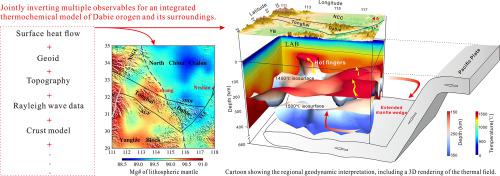当前位置:
X-MOL 学术
›
Tectonophysics
›
论文详情
Our official English website, www.x-mol.net, welcomes your
feedback! (Note: you will need to create a separate account there.)
The deep thermochemical structure of the Dabie orogenic belt from multi-observable probabilistic inversion
Tectonophysics ( IF 2.7 ) Pub Date : 2020-07-01 , DOI: 10.1016/j.tecto.2020.228478 Anqi Zhang , Zhen Guo , Juan Carlos Afonso , Yingjie Yang , Bo Yang , Yixian Xu
Tectonophysics ( IF 2.7 ) Pub Date : 2020-07-01 , DOI: 10.1016/j.tecto.2020.228478 Anqi Zhang , Zhen Guo , Juan Carlos Afonso , Yingjie Yang , Bo Yang , Yixian Xu

|
Abstract The Dabie orogenic belt (DOB) was formed by a continent-continent collision between the North China Craton (NCC) and Yangtze Block (YB) in the Middle to Late Triassic. It is thought to have experienced a large-scale orogenic collapse in the Early Cretaceous and significant modification/metasomatism during subsequent tectonic events. However, the deep thermochemical structure of the DOB and its surroundings remains poorly known. Here, we jointly invert multiple geophysical data sets with a probabilistic inversion method to obtain a 3D model of composition, bulk density and temperature beneath the DOB and surrounding areas. Our 3D model reveals high-temperature anomalies in the form of “hot fingers” beneath the eastern DOB (particularly under the Tanlu fault zone), indicating the existence of small-scale sublithospheric convection and a complex interaction between the sublithospheric mantle and the overlying lithosphere. Our imaged Mg# reveals a new NNW-trending boundary crossing the DOB, separating two distinct mantle compositional domains. The eastern DOB is characterized by a relatively thin lithosphere and lower Mg# (fertile), indicating that it has been more severely altered by the orogenic collapse and subsequent tectonic activity than the western DOB, where we observe a relatively thicker and more depleted lithospheric mantle. Finally, we combine this information with electrical conductivity data from a recent magnetotelluric profile to estimate the water content of the upper mantle. We find that the conductivity of the lithospheric mantle beneath the NCC, western DOB, and YB is controlled by water content rather than by temperature and composition. The higher water content of the lithospheric mantle beneath the NCC and YB indicates that water may have been introduced in the mantle before or during the Mesozoic and Cenozoic tectonism.
中文翻译:

多观测概率反演大别造山带深部热化学结构
摘要 大别造山带(DOB)是中、晚三叠世华北克拉通(NCC)与扬子地块(YB)陆-陆碰撞形成的。它被认为在早白垩世经历了大规模的造山崩塌,并在随后的构造事件中经历了显着的改造/交代。然而,DOB 及其周围环境的深层热化学结构仍然知之甚少。在这里,我们使用概率反演方法联合反演多个地球物理数据集,以获得 DOB 和周围区域下方的成分、体积密度和温度的 3D 模型。我们的 3D 模型揭示了东部 DOB 下方(特别是郯庐断裂带下方)以“热手指”形式出现的高温异常,表明存在小尺度亚岩石圈对流,亚岩石圈地幔与上覆岩石圈之间存在复杂的相互作用。我们的成像 Mg# 揭示了一个新的 NNW 趋势边界跨越 DOB,将两个不同的地幔成分域分开。东部DOB的特征是岩石圈相对较薄,Mg#(肥沃)较低,表明它比西部DOB受到造山崩塌和随后的构造活动更严重的改变,在西部DOB我们观察到相对更厚和更耗竭的岩石圈地幔. 最后,我们将这些信息与最近的大地电磁剖面的电导率数据相结合,以估计上地幔的含水量。我们发现 NCC 下方岩石圈地幔的电导率、DOB 西部、YB 受水含量控制,而不是受温度和成分控制。NCC和YB下方岩石圈地幔的较高含水量表明水可能在中生代和新生代构造运动之前或期间引入地幔。
更新日期:2020-07-01
中文翻译:

多观测概率反演大别造山带深部热化学结构
摘要 大别造山带(DOB)是中、晚三叠世华北克拉通(NCC)与扬子地块(YB)陆-陆碰撞形成的。它被认为在早白垩世经历了大规模的造山崩塌,并在随后的构造事件中经历了显着的改造/交代。然而,DOB 及其周围环境的深层热化学结构仍然知之甚少。在这里,我们使用概率反演方法联合反演多个地球物理数据集,以获得 DOB 和周围区域下方的成分、体积密度和温度的 3D 模型。我们的 3D 模型揭示了东部 DOB 下方(特别是郯庐断裂带下方)以“热手指”形式出现的高温异常,表明存在小尺度亚岩石圈对流,亚岩石圈地幔与上覆岩石圈之间存在复杂的相互作用。我们的成像 Mg# 揭示了一个新的 NNW 趋势边界跨越 DOB,将两个不同的地幔成分域分开。东部DOB的特征是岩石圈相对较薄,Mg#(肥沃)较低,表明它比西部DOB受到造山崩塌和随后的构造活动更严重的改变,在西部DOB我们观察到相对更厚和更耗竭的岩石圈地幔. 最后,我们将这些信息与最近的大地电磁剖面的电导率数据相结合,以估计上地幔的含水量。我们发现 NCC 下方岩石圈地幔的电导率、DOB 西部、YB 受水含量控制,而不是受温度和成分控制。NCC和YB下方岩石圈地幔的较高含水量表明水可能在中生代和新生代构造运动之前或期间引入地幔。











































 京公网安备 11010802027423号
京公网安备 11010802027423号